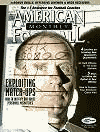AMERICAN FOOTBALL MONTHLY THE #1 RESOURCE FOR FOOTBALL COACHES
Article CategoriesAFM Magazine
|
Generation X\'s and O\'sby: Richard Scott© More from this issue Game Simulation Technology Allows you to Teach From the Field Level in Real Game Situations When Oklahoma State quarterback Bobby Reid missed significant practice snaps last fall and quarterbacks coach Larry Fedora was forced to prepare junior Al Pena for his first start, Fedora turned to technology. Fedora put a state-of-the-art football simulator produced by GridIron Technology, Inc. in the hands of his quarterbacks, allowing Reid a chance to stay mentally sharp and giving Pena more mental reps as he prepared for Saturday. With the entire Oklahoma State offense and the opponent’s defense programmed into the simulator, the quarterback used a joystick to make their reads and decisions. Instead of playing a video game such as Madden 2006 or NCAA Football 2006, the quarterbacks focus....The full article can only be seen by subscribers. Subscribe today!
|
|
|||||||
| HOME |
MAGAZINE |
SUBSCRIBE | ONLINE COLUMNISTS | COACHING VIDEOS |
Copyright 2025, AmericanFootballMonthly.com
All Rights Reserved





